The Elephant Man
aka Joseph Merrick, aka (incorrectly) John Merrick
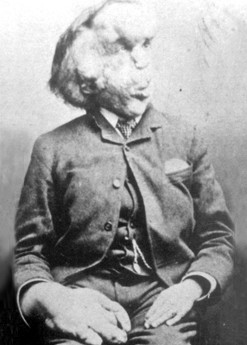 He was not an animal, he was a human being! Ironically, the one thing he wasn't was an elephant man.
He was not an animal, he was a human being! Ironically, the one thing he wasn't was an elephant man.
Joseph Merrick suffered from a rare disease which was not actually the elephantiasis that provided his unfortunate nickname. But The Proteus Syndrome Man or even worse, The Neurofibromatosis Man, wouldn't be a very good movie title, so the misdiagnosis probably worked out for the best.
Merrick was born in England in 1862. When he was a toddler, it quickly became clear that something was terribly wrong when disfiguring tumors sprouted on his face.
Merrick believed he had become deformed because his mother was frightened by an elephant. Even considering the science of the day, this was a ludicrous idea, but then again Merrick didn't get the chance to receive a high-quality education.
Merrick's mother died when he was 10. His stepmother couldn't deal with the child's escalating deformity and insisted that his father throw him out on the street. Daddy Dearest complied, and Merrick became a street urchin, albeit a not particularly adorable one.
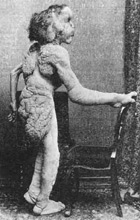 By the age of 12, Merrick was peddling shoe polish on street corners, where he was exposed to the elements as well as the taunts, bullying and general persecution of his fellow urchins. Later he became a ward of the state, forced to live and work in a welfare sweatshop, making Oliver Twist's problems seem trivial by comparison.
By the age of 12, Merrick was peddling shoe polish on street corners, where he was exposed to the elements as well as the taunts, bullying and general persecution of his fellow urchins. Later he became a ward of the state, forced to live and work in a welfare sweatshop, making Oliver Twist's problems seem trivial by comparison.
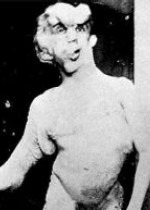 Merrick's face and body were covered with massive lumpy growths, hard tumors made of bone; he looked much like a Play-Doh bust that had been mashed and gouged by a child. A lackadaisical attempt to cut away some of the excess growth failed, and Merrick's deformity grew.
Merrick's face and body were covered with massive lumpy growths, hard tumors made of bone; he looked much like a Play-Doh bust that had been mashed and gouged by a child. A lackadaisical attempt to cut away some of the excess growth failed, and Merrick's deformity grew.
Everywhere he went, crowds gathered around to gape at his deformities, without paying so much as a dime. Putting two and two together, Merrick decided to pursue the most obvious career choice that lay before him -- sideshow freak. If he was going to be a spectacle, he could at least profit from the process.
Despite popular myths about the Elephant Man, Merrick wrote in a short autobiography that his time as a sideshow freak wasn't particularly sordid or hurtful. Real life was hurtful. In the sideshow, Merrick said, he was treated only with the "greatest kindness."
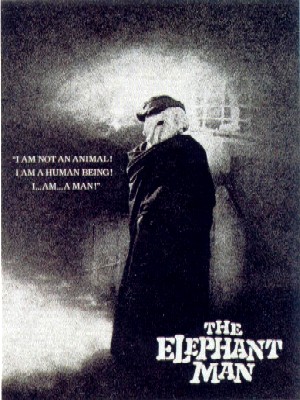 Many misconceptions about Merrick's life stem from the popular 1980 movie, The Elephant Man (directed by David Lynch), which depicts Merrick as a lost soul who was abused at the sideshow and deprived of his dignity, which he was then forced to laboriously reclaim, uttering at one point, "I am not an animal! I am a human being!"
Many misconceptions about Merrick's life stem from the popular 1980 movie, The Elephant Man (directed by David Lynch), which depicts Merrick as a lost soul who was abused at the sideshow and deprived of his dignity, which he was then forced to laboriously reclaim, uttering at one point, "I am not an animal! I am a human being!"
The movie lays waste to Merrick's dignity far more comprehensively than anything that happened in his real life. Merrick appears to be unable to communicate (in life, he had difficulty speaking because of tumors on his jaw, but he could write very serviceably). The circus owner, whom the real Merrick considered a kind friend, is painted as a drunken bully. The movie even got his name wrong, calling him John Merrick (repeating an earlier chronicler's mistake).
Merrick's time with the sideshow went quite well, according to his own account, but ended on a sour note when the money he had been saving was stolen by a crooked promoter in Belgium. Penniless and in declining health, Merrick returned to England.
Merrick's appearance precipitated a mob scene. When police answered the call of public disturbance, they found a card for Dr. Frederick Treves and deposited Merrick at the London Hospital.
Treves was a physician who had visited the sideshow a few years earlier in order to study the Elephant Man's affliction. A prominent anatomy specialist, Treves would later be knighted for his glorious efforts in performing a routine appendectomy on King Edward VII. Treves initially diagnosed Merrick with elephantiasis, a disease in which the lymphatic system goes nuts and large, hard tumors grow around the legs and genitals.
 Merrick's deformity continued to grow unchecked. In addition to the huge, boney tumors on his head -- which eventually reached a circumference of three feet -- a constellation of tumors sprouted all over his body, some hard, some soft, some just right. His left arm was normal to all appearances, but the rest of his body slowly distorted into phantasmagoric shapes, even more uncomfortable to possess than they were to see.
Merrick's deformity continued to grow unchecked. In addition to the huge, boney tumors on his head -- which eventually reached a circumference of three feet -- a constellation of tumors sprouted all over his body, some hard, some soft, some just right. His left arm was normal to all appearances, but the rest of his body slowly distorted into phantasmagoric shapes, even more uncomfortable to possess than they were to see.
Despite Treves' care, Merrick's health declined because of his disease, and he slipped into a rather understandable state of depression. Treves collected donations and solicited volunteers to provide care for Merrick when the hospital refused to foot his bills.
After the newspapers had their way, Merrick grew a bit of celebrity, his hospital room pupating into a classy sideshow. Members of the royal family and other nobility coming to pay their respects and do whatever inbred aristocrats do instead of gawking like yokels.
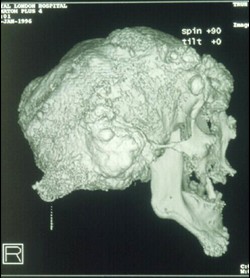 Merrick wanted nothing more than to emerge into the world again, and in 1889, he took a six week vacation out in nature, far away from the prying eyes of the public.
Merrick wanted nothing more than to emerge into the world again, and in 1889, he took a six week vacation out in nature, far away from the prying eyes of the public.
Although his life had been filled with clamor, his death came quietly. Merrick died in bed at the age of 27. Through his life, Merrick had slept in an upright position because of his deformities, but on the night of April 11, 1890, he lay down on his back in bed and apparently asphyxiated from the weight of his chest.
Even in death, Merrick continued to be the center of a swirl of controversy, much of it centered on his diagnosis. Treves' misdiagnosis of elephantiasis endured until the 1970s, when doctors revised their opinion and speculated that Merrick had suffered from neurofibromatosis, a genetic disease linked to scoliosis and cancer that produces a similar disfigurement.
The neurofibromatosis verdict lasted almost 20 more years, but the photographic record of Merrick's deformity and his skeleton, which had been preserved for science, didn't quite match the disease's indicators.
In 1996, a new theory proposed that Merrick had suffered from Proteus Syndrome. DNA tests carried out on the Elephant Man's remains in 2003 confirmed that diagnosis, although there is still some question about whether he also had neurofibromatosis. Further testing is planned, and we're sure you're all waiting on the edge of your seats for the results, in hopes that the warring Proteus Syndrome and neurofibromatosis camps can finally put away all the hard feelings and bloodshed once and for all.
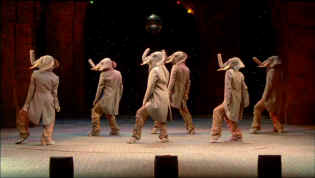 In death, Merrick failed to get the peace he deserved. In addition to the 1980 movie, he was the subject of a serious play by Bernard Pomerance and a not-so-serious parody of a stage musical within a movie (Elephant!, the star role won by Jeff Goldblum's character in The Tall Guy).
In death, Merrick failed to get the peace he deserved. In addition to the 1980 movie, he was the subject of a serious play by Bernard Pomerance and a not-so-serious parody of a stage musical within a movie (Elephant!, the star role won by Jeff Goldblum's character in The Tall Guy).
Then there was the whole Michael Jackson thing.
In 1987, "reports emerged" that Jackson had attempted to buy the bones of the Elephant Man. This incident has since been cited in virtually every news story written about Jackson's bizarre behavior, which, as you can imagine, makes for rather a lot of citations.
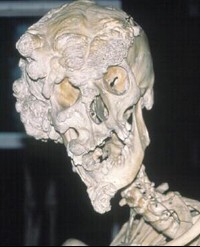
Trying to find out who actually first reported this alleged story is like trying to get a snapshot of the interior of Hangar 18 at Area 51. All of the aforementioned citations simply say that these "reports emerged" without specifying where they emerged from. Furthermore, Jackson has denied the story in public appearances, such as on Oprah, where he derided the slander-mongers who made such outrageous claims.
That's another stupid story. I love the story of the Elephant man, he reminds me of me a lot, and I could relate to it, it made me cry because I saw myself in the story, but no I never asked for the... where am I going to put some bones? And why would I want some bones?
Why indeed! It turns out that Jackson began to ask himself that question only after issuing a press release trumpeting this latest outbreak of insanity -- conveniently submerged in the PR blitz which anticipated the now octuple-platinum Bad (1987). Buried in the dusty archives of PR Newswire, we found the following announcement:

DATELINE: LOS ANGELES, May 29
LOS ANGELES, May 29 /PRN/ -- Michael Jackson has submitted an official bid, for an undisclosed sum, for the remains of the late John Merrick, known as the Elephant Man, from the London Hospital Medical College which has kept them since Merrick's death in 1890.
According to Jackson's manager, Frank Dileo of Los Angeles: "Jackson has a high degree of respect for the memory of Merrick. He has read and studied all material about the Elephant Man, and has visited the hospital in London twice to view Merrick's remains. His fascination with their historical significance increased with each visit, along with hopes to add them to his collection of rare and unusual memorabilia at his California compound."
"Jackson," Dileo added, "has no exploitative intentions whatsoever and cares about and is concerned with the Elephant Man as a dedicated and devoted collector of art and antiques.
CONTACT -- Lee Solters or Eliot Sekuler of Solters/Roskin/ Friedman, 213-XXX-XXXX, for Michael Jackson
What? Michael Jackson lied to Oprah?! Regardless of Jacko's falsetto, he must have some serious balls.
After an initial rebuff, Jackson eventually bid $1 million for the bones, a bid which was rejected as soundly as all his previous bids, and he finally abandoned the effort and (as we have seen) subsequently denied it had ever taken place.